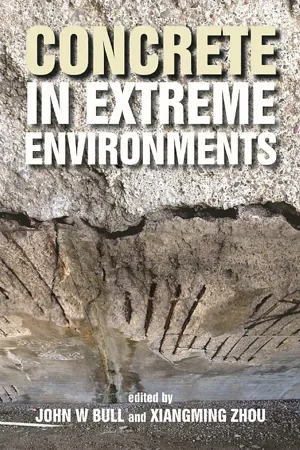
- English
- PDF
- Available on iOS & Android
Concrete in Extreme Environments
About this book
Contemporary events have shown that buildings designed to modern day codes need to be able to resist accidental extreme actions such as impact, explosions, weather, chemical and seismic events. This is one of the reasons for the present reviewing of the Eurocodes used to design concrete structures. The definition of the use of concrete used in extreme environments is difficult, but extreme events are usually defined as those rare events which occur at the extreme ends of the statistical distribution in a particular situation. Often the clients who order the concrete structures are unable to determine the extremes of environments the concrete will encounter and rely on the designers and construction companies to be able to predict the service conditions.
Frequently asked questions
- Essential is ideal for learners and professionals who enjoy exploring a wide range of subjects. Access the Essential Library with 800,000+ trusted titles and best-sellers across business, personal growth, and the humanities. Includes unlimited reading time and Standard Read Aloud voice.
- Complete: Perfect for advanced learners and researchers needing full, unrestricted access. Unlock 1.4M+ books across hundreds of subjects, including academic and specialized titles. The Complete Plan also includes advanced features like Premium Read Aloud and Research Assistant.
Please note we cannot support devices running on iOS 13 and Android 7 or earlier. Learn more about using the app.
Information
Table of contents
- Title page
- Contents
- The Editors
- The Authors
- Chapter 1 Introduction
- Chapter 2 Recognising severe environments
- Chapter 3 Effects of typical extreme environments on concrete dams
- Chapter 4 Extreme response of reinforced concrete framed buildings using static and dynamic procedures for progressive collapse analysis
- Chapter 5 Use of calcium aluminate cements in sewer networks submitted to H2S biogenic corrosion
- Chapter 6 High cycle fatigue of concrete structures in harsh environments : design and monitoring
- Appendix A MATLAB code for probabilistic model of concrete fatigue
- Chapter 7 Validation of models for prediction of chloride ingress in concrete exposed to a de-icing salt road environment
- Appendix 7A Guidelines for application of the ClinConc model in durability design
- Chapter 8 Evolution of corrosion parameters in a buried pilot nuclear waste container in El Cabril
- Chapter 9 Reactions of cements in geothermal wells
- Index